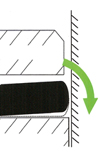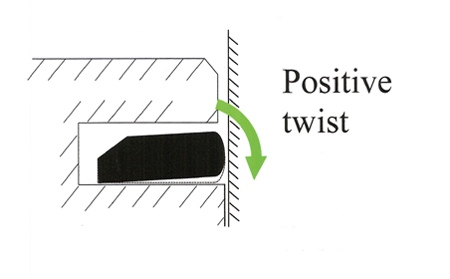A twist in the tale
 For all its apparent simplicity, your typical piston ring is a complex device. Required to seal against combustion gases on the power stroke and yet minimise friction on the upstroke, under all conditions of speeds and loads, the task might seem possible if we include the additional demand that all this and more should be achieved with the minimum of weight.
For all its apparent simplicity, your typical piston ring is a complex device. Required to seal against combustion gases on the power stroke and yet minimise friction on the upstroke, under all conditions of speeds and loads, the task might seem possible if we include the additional demand that all this and more should be achieved with the minimum of weight.
It is perhaps little wonder therefore that under the high-speed dynamic loads experienced, rings tend to move in ways not originally foreseen. That the ring, whatever its position down the piston skirt - be it top, second or oil control - should be a clearance fit inside its retaining piston ring groove is surely an obvious necessity. Enabling the ring to move in and out, this gap also allows that on the power stroke combustion gases can pass down the top land travel into the gap and push the ring radially outwards against the cylinder bore. This assists sealing on the power stroke, and at the same time reduces the contact force throughout the rest of the cycle when it is not really needed.
Capable of moving in and out as well as up and down within its groove, the position of the ring is governed by its inertia, the gas pressures above it, the frictional forces and the distribution of the other pressures along its flanks as well as those on the running surface. Moving up and down, ordinarily the ring will seal on its lower flank and against the cylinder wall, at which time all these forces as well as the moments induced will be balanced.
However, under some dynamic conditions these can become unbalanced, and the ring can move in ways not originally intended. Unbalanced forces can introduce additional bending moments at various times during the piston cycle, for instance, causing the ring to bend or twist in its groove at various points around its circumference. During this process the flow of combustion gas around and behind the ring may be interrupted, but so long as a net radial force between ring and liner wall continues to exist then the ring will continue to seal. When this isn't the case, and the radial force disappears, the ring will collapse away from the wall, introducing a new and potentially devastating leakage path for both gas going down and oil coming up.
To prevent this, rings can be made to give either a positive or a negative twist depending on the particular problem encountered.

As a particular example, I remember some years ago a durability test identifying excessive crankcase blow-by above a particular high engine speed. Specifying a positive twist compression ring, a chamfer was introduced to its top inside edge, causing it to flex down in response to the introduction of combustion gas pressure. At high engine speeds this gave better sealing and a reduction in blow-by.
To understand a little of what was happening the engineer I was with compressed the ring so that the two free ends came together, at which point the ring took on a slight positive twist. When combustion gas was introduced, or so the theory stated, the ring twisted downwards and perpendicular again to the liner, producing a better seal.
Surely a case of when a twist in the story produces a better ending.
Fig. 1 - A positive twisted ring
Written by John Coxon